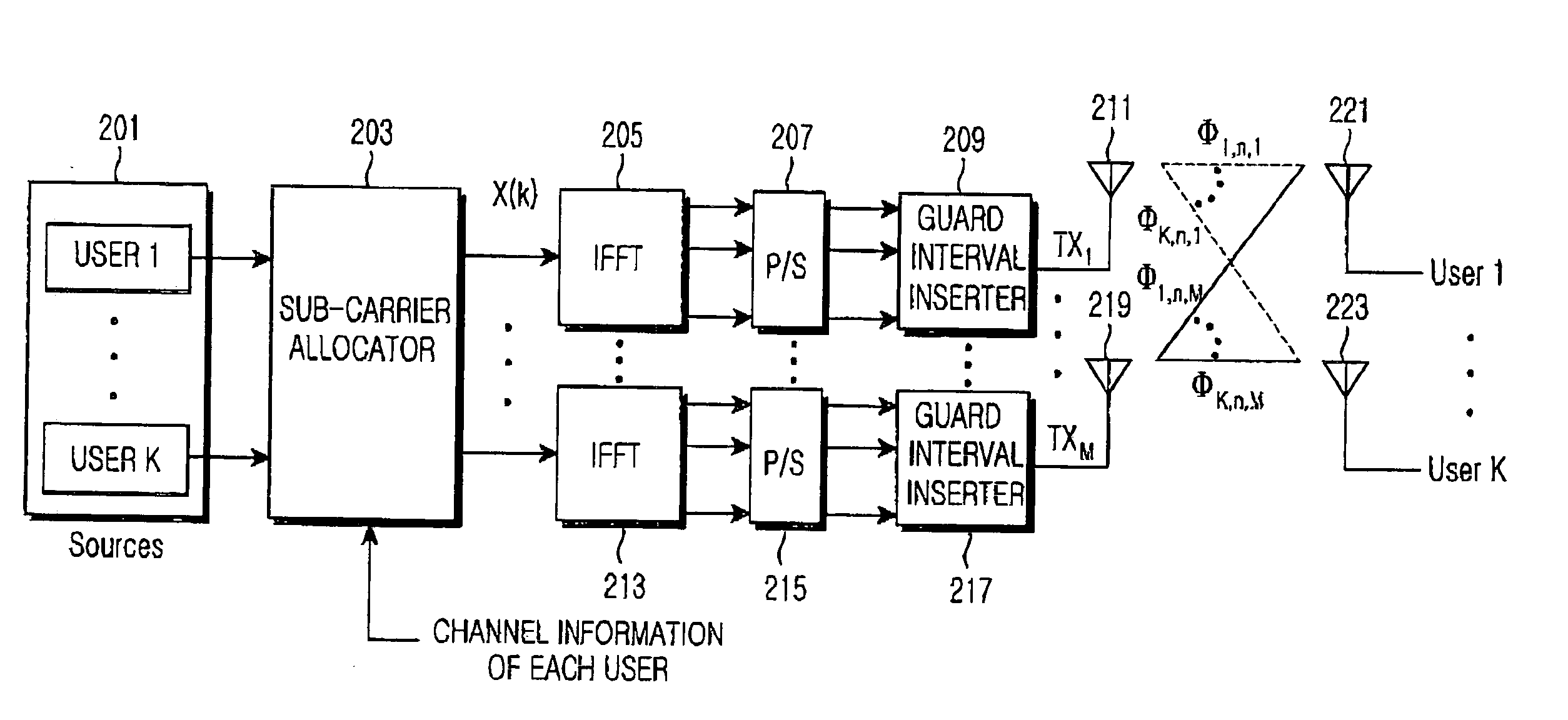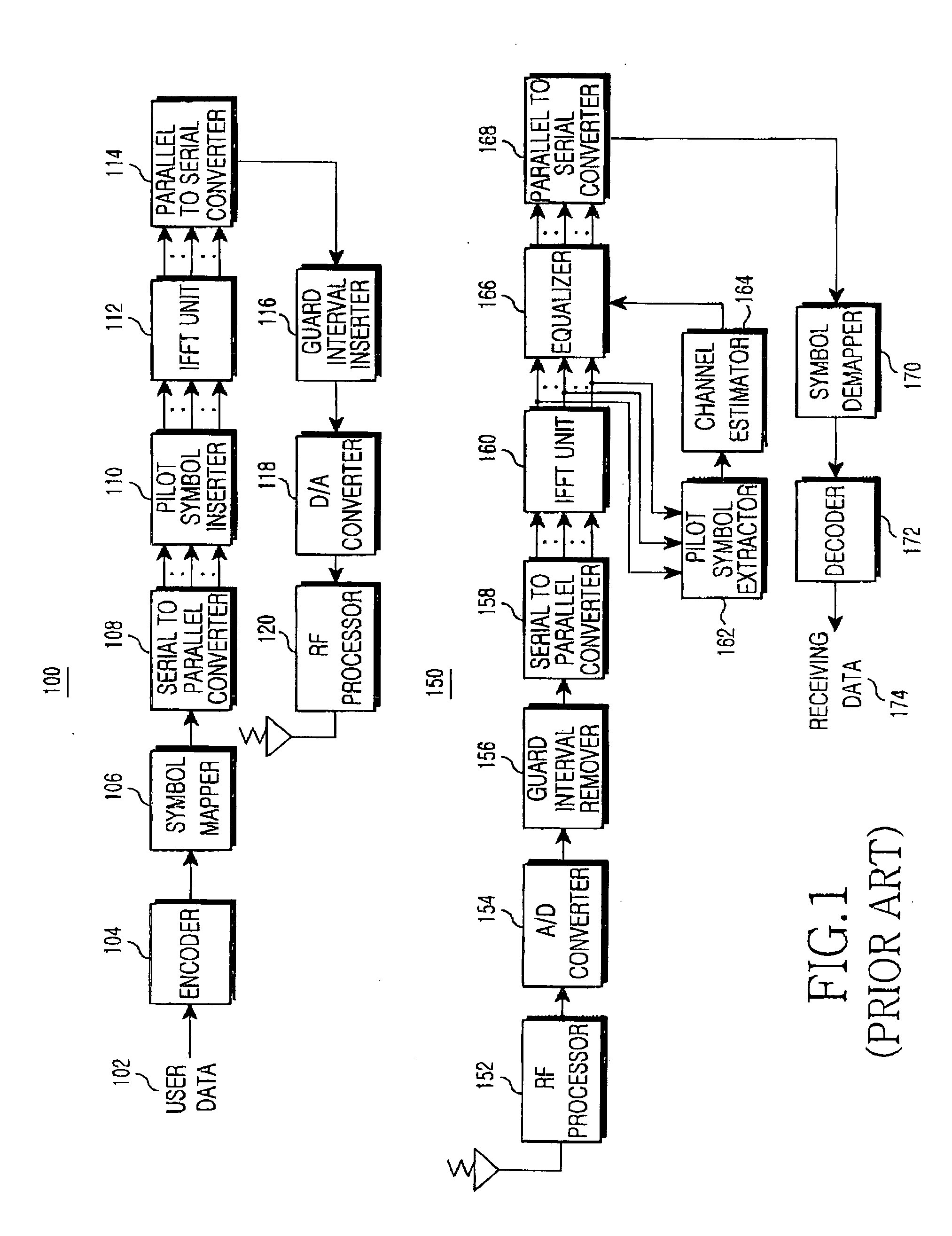Apparatus and method for sub-carrier allocation in a multiple-input and multiple-output (MIMO) orthogonal frequency division multiplexing (OFDM) communication system
a communication system and multi-input multi-output technology, applied in the field of mobile communication systems, can solve the problems of signal distortion, multi-path interference of transmitted signals, and increase the complexity of equalizers at receiving terminals
- Summary
- Abstract
- Description
- Claims
- Application Information
AI Technical Summary
Benefits of technology
Problems solved by technology
Method used
Image
Examples
embodiment 1
[0053] Embodiment 1
[0054] According to a first embodiment of the present invention, channel information for all sub-carriers in antennas is obtained before a user signal is transmitted. Then, the user signal is transmitted by using the channel information. In addition, the channel information is fed back after a predetermined time lapse for the sake of channel state variation. At this time an amount of the channel information is M×N, in which M is the number of antennas, and N is the number of sub-carriers.
[0055] Prior to explaining the sub-carrier allocation algorithm according to the first embodiment of the present invention, the channel information which needs to be sent from each user equipment to a base station for sub-carrier allocation will be described.
[0056] According to the first embodiment of the present invention, the number nk of sub-carriers to be allocated to each user in OFDMA scheme is determined. Then, sub-carriers to be allocated to each user are determined thro...
first embodiment
[0097]FIG. 5 is a flow chart illustrating a procedure for allocating sub-carriers and antennas to each user according to the present invention.
[0098] Referring to FIG. 5, a sub-carrier allocation matrix Ak,n,m is set to “0” at step 501. The sub-carrier allocation matrix A indicates a use of the sub-carrier in each antenna per each user k. In addition, in order to allocate the sub-carriers, the reference priority P0(k) is calculated based on Equation 5, and a set S1 of sub-carriers, in which the sub-carriers are aligned in an order of an nk value, is determined, thereby selecting a user having the greatest number of sub-carriers to be allocated thereto.
[0099] Then, in step 503, Φ−1k,n,m is obtained by using feedback channel information of a kth user, and a sub-carrier n and an antenna m having a minimum value are searched. Subsequently, a value of nk is reduced by one in step 505, and Ak,n,m corresponding to the sub-carrier and the antenna searched from the sub-carrier allocation ma...
embodiment 2
[0101] Embodiment 2
[0102] Hereinafter, an apparatus and a method for allocating sub-carriers according to a second embodiment of the present invention will be described with reference to FIGS. 6 and 7.
[0103] First, a structure of a transmitter in a MIMO OFDMA system according to a second embodiment of the present invention will be described with reference to FIG. 6. Referring to FIG. 6, user data are converted into parallel data by means of a serial to parallel converter 601 and is divided into at least one sub-carrier group 605 and 607 by means of a group allocator 603. If the group is allocated in a sub-carrier unit, a group size L=1. A plurality of sub-carriers are combined as one group.
[0104] Such a group allocation is performed by means of a group allocation controller 611 according to channel information received from receivers 617 and 619. The group is allocated while taking a channel state of the sub-carrier in each antenna per each user into consideration. The sub-carrier...
PUM
 Login to View More
Login to View More Abstract
Description
Claims
Application Information
 Login to View More
Login to View More - R&D
- Intellectual Property
- Life Sciences
- Materials
- Tech Scout
- Unparalleled Data Quality
- Higher Quality Content
- 60% Fewer Hallucinations
Browse by: Latest US Patents, China's latest patents, Technical Efficacy Thesaurus, Application Domain, Technology Topic, Popular Technical Reports.
© 2025 PatSnap. All rights reserved.Legal|Privacy policy|Modern Slavery Act Transparency Statement|Sitemap|About US| Contact US: help@patsnap.com



